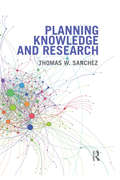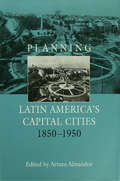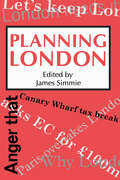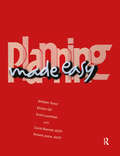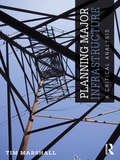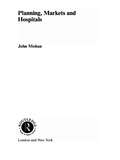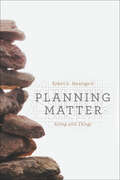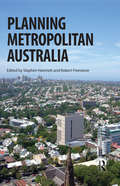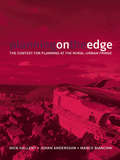- Table View
- List View
Planning Knowledge and Research
by Thomas W. SanchezThe field of urban planning is far-reaching in breadth and depth. This is due to the complex nature of cities, regions, and development processes. The knowledge domain of planning includes social, economic, technological, environmental, and political systems that continue to evolve and expand rapidly. Understanding these systems is an inter-disciplinary endeavor at the scale of several academic fields. The wide range of topics considered by planning educators and practitioners are often based on varying definitions of "planning" and modes of planning practice. This unique book discusses various elements and contributions to urban planning research to show that seemingly disparate topics do in fact intersect and together, contribute to ways of understanding urban planning. The objective is not to discuss how to "do" research, but rather, to explore the context of urban planning scholarship with implications for the planning academy and planning practice. This edited volume includes chapters contributed by a diverse range of planning scholars who consider the corpus of planning scholarship both historically and critically in their area of expertise. It is essential reading for students of planning research and planning theory from around the world.
Planning Knowledge and Research
by Thomas W. SanchezThe field of urban planning is far-reaching in breadth and depth. This is due to the complex nature of cities, regions, and development processes. The knowledge domain of planning includes social, economic, technological, environmental, and political systems that continue to evolve and expand rapidly. Understanding these systems is an inter-disciplinary endeavor at the scale of several academic fields. The wide range of topics considered by planning educators and practitioners are often based on varying definitions of "planning" and modes of planning practice. This unique book discusses various elements and contributions to urban planning research to show that seemingly disparate topics do in fact intersect and together, contribute to ways of understanding urban planning. The objective is not to discuss how to "do" research, but rather, to explore the context of urban planning scholarship with implications for the planning academy and planning practice. This edited volume includes chapters contributed by a diverse range of planning scholars who consider the corpus of planning scholarship both historically and critically in their area of expertise. It is essential reading for students of planning research and planning theory from around the world.
Planning Labour: Time and the Foundations of Industrial Socialism in Romania (International Studies in Social History #32)
by Alina-Sandra CucuImpoverished, indebted, and underdeveloped at the close of World War II, Romania underwent dramatic changes as part of its transition to a centrally planned economy. As with the Soviet experience, it pursued a policy of “primitive socialist accumulation” whereby the state appropriated agricultural surplus and restricted workers’ consumption in support of industrial growth. Focusing on the daily operations of planning in the ethnically mixed city of Cluj from 1945 to 1955, this book argues that socialist accumulation was deeply contradictory: it not only inherited some of the classical tensions of capital accumulation, but also generated its own, which derived from the multivocal nature of the state socialist worker as a creator of value, as living labour, and as a subject of emancipatory politics.
Planning Latin America's Capital Cities 1850-1950 (Planning, History And The Environment Ser.)
by Arturo AlmandozIn this first comprehensive work in English to describe the building of Latin America's capital cities in the postcolonial period, Arturo Almandoz and his contributors demonstrate how Europe and France in particular shaped their culture, architecture and planning until the United States began to play a part in the 1930s. The book provides a new per
Planning Latin America's Capital Cities 1850-1950
by Arturo AlmandozIn this first comprehensive work in English to describe the building of Latin America's capital cities in the postcolonial period, Arturo Almandoz and his contributors demonstrate how Europe and France in particular shaped their culture, architecture and planning until the United States began to play a part in the 1930s. The book provides a new per
Planning London
by James SimmieAn introduction to the problems and practices of planning in London. The authors address the question of what contributions the land-use planning system has made and could make to resolving decrepit public transport, congestion, noise, dirt, crime, poverty, begging, homelessness. They analyse these conflicts in terms of history, jobs, housing, transport and the quality of the environment - and considers future options.
Planning London: The Case Of London (Progress In Planning Ser.)
by James SimmieAn introduction to the problems and practices of planning in London. The authors address the question of what contributions the land-use planning system has made and could make to resolving decrepit public transport, congestion, noise, dirt, crime, poverty, begging, homelessness. They analyse these conflicts in terms of history, jobs, housing, transport and the quality of the environment - and considers future options.
Planning London for the Post-War Era 1945-1960 (Springer Geography)
by Emmanuel V. MarmarasThis book deals with the formation of the post-Second World War reconstruction and planning machinery in Great Britain, the re-planning efforts undertaken in post-war London, and in particular the redevelopment programme regarding its central area in the form of the comprehensive development projects. Originating from a PhD Thesis, the book recreates the atmosphere following step by step arguments and events at various political, socio-economic and technical levels. It also contributes to the understanding of succeeding developments in terms of planning theory and practice. The book is structured into three parts. The first one explores the administrative and statutory developments in town planning matters during the period 1940-59. The second part deals with the plans proposed for London as a whole from independent and official organisations mainly during the 1940s. Finally, the third part examines the proposed projects for the rebuilding of the City of London and for special areas of Central London that suffered from bombing on both sides of the Thames.
Planning Los Angeles
by David SloaneLos Angeles isn’t planned; it just happens. Right? Not so fast! Despite the city’s reputation for spontaneous evolution, a deliberate planning process shapes the way Los Angeles looks and lives. Editor David C. Sloane, a planning professor at the University of Southern California, has enlisted 30 essayists for a lively, richly illustrated view of this vibrant metropolis. Planning Los Angeles launches a new series from APA Planners Press. Each year Planners Press will bring out a new study on a major American city. Natives, newcomers, and out-of-towners will get insiders’ views of today’s hot-button issues and a sneak peek at the city to come.
Planning Los Angeles: Artists And Communities Working Together (Routledge Research In Planning And Urban Design Ser.)
by David C. SloaneLos Angeles isn’t planned; it just happens. Right? Not so fast! Despite the city’s reputation for spontaneous evolution, a deliberate planning process shapes the way Los Angeles looks and lives. Editor David C. Sloane, a planning professor at the University of Southern California, has enlisted 30 essayists for a lively, richly illustrated view of this vibrant metropolis. Planning Los Angeles launches a new series from APA Planners Press. Each year Planners Press will bring out a new study on a major American city. Natives, newcomers, and out-of-towners will get insiders’ views of today’s hot-button issues and a sneak peek at the city to come.
Planning Made Easy
by William Toner Efraim Gil Enid Lucchesi Carol Barrett Robert JoiceDeveloping a program to train planning commissioners and zoning board members takes a lot of time and effort. This manual makes the process easier. It covers the basics of community planning, zoning, subdivision regulation, and ethics. With chapters organized in discrete modules, it's ideal for both self-study and classroom use. Narratives explain general planning principles. Exercises encourage users to think about the planning issues in their communities. And worksheets reinforce important concepts. A complementary training guide, Training Made Easy, is also available. Planning Made Easy is published as looseleaf pages in a three-ring notebook.
Planning Made Easy
by William Toner Efraim Gil Enid Lucchesi Carol Barrett Robert JoiceDeveloping a program to train planning commissioners and zoning board members takes a lot of time and effort. This manual makes the process easier. It covers the basics of community planning, zoning, subdivision regulation, and ethics. With chapters organized in discrete modules, it's ideal for both self-study and classroom use. Narratives explain general planning principles. Exercises encourage users to think about the planning issues in their communities. And worksheets reinforce important concepts. A complementary training guide, Training Made Easy, is also available. Planning Made Easy is published as looseleaf pages in a three-ring notebook.
Planning Major Infrastructure: A Critical Analysis
by Tim MarshallThis book analyses the planning and policy world of major infrastructure as it is moving now in Europe and the UK. Have some countries managed to generate genuine consensus on how the large changes are progressed? What can we learn from the different ways countries manage these challenges, to inform better spatial planning and more intelligent political steering? Case studies of the key features of policy and planning approaches in France, Germany, the Netherlands, Spain and the UK are at the core of Planning Major Infrastructure. This includes the different regimes introduced in England and Wales, and Scotland, brought in by reforms since 2006. High speed rail, renewable energy deployment, water management, waste treatment – all raise critical planning issues. The case studies connect to the big issues of principle which haunt this field of public policy: how can democratic legitimacy be secured? How can ecological and economic transitions be managed? What is the appropriate role of the national government in each of these areas, as against other levels? What part has the EU played, and should it be involved in the future? These are some of the central themes raised in this innovating exploration of this currently high profile field.
Planning Major Infrastructure: A Critical Analysis
by Tim MarshallThis book analyses the planning and policy world of major infrastructure as it is moving now in Europe and the UK. Have some countries managed to generate genuine consensus on how the large changes are progressed? What can we learn from the different ways countries manage these challenges, to inform better spatial planning and more intelligent political steering? Case studies of the key features of policy and planning approaches in France, Germany, the Netherlands, Spain and the UK are at the core of Planning Major Infrastructure. This includes the different regimes introduced in England and Wales, and Scotland, brought in by reforms since 2006. High speed rail, renewable energy deployment, water management, waste treatment – all raise critical planning issues. The case studies connect to the big issues of principle which haunt this field of public policy: how can democratic legitimacy be secured? How can ecological and economic transitions be managed? What is the appropriate role of the national government in each of these areas, as against other levels? What part has the EU played, and should it be involved in the future? These are some of the central themes raised in this innovating exploration of this currently high profile field.
Planning, Markets and Hospitals
by John MohanImproving access to hospital services has been a goal of public policy in Britain for over seventy years, but the means by which this goal is to be attained have changed significantly over time. Drawing substantially on original research, lanning, Markets and Hospitals represents a systematic attempt to access the strengths and weaknesses of different forms of planning and coordination of hospital development.The period covered includes: services prior to 1948; wartime hospital policy; the successes and failures of the mixed economy of health care in the inter-war period; the national hospital plan of 1962 and ultimately the market based reforms of 1991 and the changes since.This book makes a fresh contribution to enduring debates about planning and regulation of health care, about the governance of welfare services and about the appropriate role for voluntary, commercial and charitable provision of services. It reinterprets previous histories of hospital policy and questions whether current policies will reconcile competing goals of equity and choice.
Planning, Markets and Hospitals
by John MohanImproving access to hospital services has been a goal of public policy in Britain for over seventy years, but the means by which this goal is to be attained have changed significantly over time. Drawing substantially on original research, lanning, Markets and Hospitals represents a systematic attempt to access the strengths and weaknesses of different forms of planning and coordination of hospital development.The period covered includes: services prior to 1948; wartime hospital policy; the successes and failures of the mixed economy of health care in the inter-war period; the national hospital plan of 1962 and ultimately the market based reforms of 1991 and the changes since.This book makes a fresh contribution to enduring debates about planning and regulation of health care, about the governance of welfare services and about the appropriate role for voluntary, commercial and charitable provision of services. It reinterprets previous histories of hospital policy and questions whether current policies will reconcile competing goals of equity and choice.
Planning Matter: Acting with Things
by Robert A. BeauregardCity and regional planners talk constantly about the things of the world—from highway interchanges and retention ponds to zoning documents and conference rooms—yet most seem to have a poor understanding of the materiality of the world in which they’re immersed. Too often planners treat built forms, weather patterns, plants, animals, or regulatory technologies as passively awaiting commands rather than actively involved in the workings of cities and regions. In the ambitious and provocative Planning Matter, Robert A. Beauregard sets out to offer a new materialist perspective on planning practice that reveals the many ways in which the nonhuman things of the world mediate what planners say and do. Drawing on actor-network theory and science and technology studies, Beauregard lays out a framework that acknowledges the inevitable insufficiency of our representations of reality while also engaging more holistically with the world in all of its diversity—including human and nonhuman actors alike.
Planning Matter: Acting with Things
by Robert A. BeauregardCity and regional planners talk constantly about the things of the world—from highway interchanges and retention ponds to zoning documents and conference rooms—yet most seem to have a poor understanding of the materiality of the world in which they’re immersed. Too often planners treat built forms, weather patterns, plants, animals, or regulatory technologies as passively awaiting commands rather than actively involved in the workings of cities and regions. In the ambitious and provocative Planning Matter, Robert A. Beauregard sets out to offer a new materialist perspective on planning practice that reveals the many ways in which the nonhuman things of the world mediate what planners say and do. Drawing on actor-network theory and science and technology studies, Beauregard lays out a framework that acknowledges the inevitable insufficiency of our representations of reality while also engaging more holistically with the world in all of its diversity—including human and nonhuman actors alike.
Planning Matter: Acting with Things
by Robert A. BeauregardCity and regional planners talk constantly about the things of the world—from highway interchanges and retention ponds to zoning documents and conference rooms—yet most seem to have a poor understanding of the materiality of the world in which they’re immersed. Too often planners treat built forms, weather patterns, plants, animals, or regulatory technologies as passively awaiting commands rather than actively involved in the workings of cities and regions. In the ambitious and provocative Planning Matter, Robert A. Beauregard sets out to offer a new materialist perspective on planning practice that reveals the many ways in which the nonhuman things of the world mediate what planners say and do. Drawing on actor-network theory and science and technology studies, Beauregard lays out a framework that acknowledges the inevitable insufficiency of our representations of reality while also engaging more holistically with the world in all of its diversity—including human and nonhuman actors alike.
Planning Matter: Acting with Things
by Robert A. BeauregardCity and regional planners talk constantly about the things of the world—from highway interchanges and retention ponds to zoning documents and conference rooms—yet most seem to have a poor understanding of the materiality of the world in which they’re immersed. Too often planners treat built forms, weather patterns, plants, animals, or regulatory technologies as passively awaiting commands rather than actively involved in the workings of cities and regions. In the ambitious and provocative Planning Matter, Robert A. Beauregard sets out to offer a new materialist perspective on planning practice that reveals the many ways in which the nonhuman things of the world mediate what planners say and do. Drawing on actor-network theory and science and technology studies, Beauregard lays out a framework that acknowledges the inevitable insufficiency of our representations of reality while also engaging more holistically with the world in all of its diversity—including human and nonhuman actors alike.
Planning Matter: Acting with Things
by Robert A. BeauregardCity and regional planners talk constantly about the things of the world—from highway interchanges and retention ponds to zoning documents and conference rooms—yet most seem to have a poor understanding of the materiality of the world in which they’re immersed. Too often planners treat built forms, weather patterns, plants, animals, or regulatory technologies as passively awaiting commands rather than actively involved in the workings of cities and regions. In the ambitious and provocative Planning Matter, Robert A. Beauregard sets out to offer a new materialist perspective on planning practice that reveals the many ways in which the nonhuman things of the world mediate what planners say and do. Drawing on actor-network theory and science and technology studies, Beauregard lays out a framework that acknowledges the inevitable insufficiency of our representations of reality while also engaging more holistically with the world in all of its diversity—including human and nonhuman actors alike.
Planning Matter: Acting with Things
by Robert A. BeauregardCity and regional planners talk constantly about the things of the world—from highway interchanges and retention ponds to zoning documents and conference rooms—yet most seem to have a poor understanding of the materiality of the world in which they’re immersed. Too often planners treat built forms, weather patterns, plants, animals, or regulatory technologies as passively awaiting commands rather than actively involved in the workings of cities and regions. In the ambitious and provocative Planning Matter, Robert A. Beauregard sets out to offer a new materialist perspective on planning practice that reveals the many ways in which the nonhuman things of the world mediate what planners say and do. Drawing on actor-network theory and science and technology studies, Beauregard lays out a framework that acknowledges the inevitable insufficiency of our representations of reality while also engaging more holistically with the world in all of its diversity—including human and nonhuman actors alike.
Planning Metropolitan Australia (Planning, History and Environment Series)
by Stephen Hamnett Robert FreestoneAustralia has long been a highly (sub)urbanized nation, but the major distinctive feature of its contemporary settlement pattern is that the great majority of Australians live in a small number of large metropolitan areas focused on the state capital cities. The development and application of effective urban policy at a regional scale is a significant global challenge given the complexities of urban space and governance. Building on the editors’ previous collection The Australian Metropolis: A Planning History (2000), this new book examines the recent history of metropolitan planning in Australia since the beginning of the twenty-first century. After a historical prelude, the book is structured around a series of six case studies of metropolitan Melbourne, Sydney, Adelaide, Perth, the fast-growing metropolitan region of South-East Queensland centred on Brisbane, and the national capital of Canberra. These essays are contributed by some of Australia’s leading urbanists. Set against a dynamic background of economic change, restructured land uses, a more diverse population, and growing spatial and social inequality, the book identifies a broad planning consensus around the notion of making Australian cities more contained, compact and resilient. But it also observes a continuing gulf between the simplified aims of metropolitan strategies and our growing understanding of the complex functioning of the varied communities in which most people live. This book reflects on the raft of planning challenges presented at the metropolitan scale, looks at what the future of Australian cities might be, and speculates about the prospects of more effective metropolitan planning arrangements.
Planning Metropolitan Australia (Planning, History and Environment Series)
by Stephen Hamnett Robert FreestoneAustralia has long been a highly (sub)urbanized nation, but the major distinctive feature of its contemporary settlement pattern is that the great majority of Australians live in a small number of large metropolitan areas focused on the state capital cities. The development and application of effective urban policy at a regional scale is a significant global challenge given the complexities of urban space and governance. Building on the editors’ previous collection The Australian Metropolis: A Planning History (2000), this new book examines the recent history of metropolitan planning in Australia since the beginning of the twenty-first century. After a historical prelude, the book is structured around a series of six case studies of metropolitan Melbourne, Sydney, Adelaide, Perth, the fast-growing metropolitan region of South-East Queensland centred on Brisbane, and the national capital of Canberra. These essays are contributed by some of Australia’s leading urbanists. Set against a dynamic background of economic change, restructured land uses, a more diverse population, and growing spatial and social inequality, the book identifies a broad planning consensus around the notion of making Australian cities more contained, compact and resilient. But it also observes a continuing gulf between the simplified aims of metropolitan strategies and our growing understanding of the complex functioning of the varied communities in which most people live. This book reflects on the raft of planning challenges presented at the metropolitan scale, looks at what the future of Australian cities might be, and speculates about the prospects of more effective metropolitan planning arrangements.
Planning on the Edge
by Nick Gallent Johan Andersson Marco BianconiMore than a tenth of the land mass of the UK comprises 'urban fringe': the countryside around towns that has been called 'planning's last frontier'. One of the key challenges facing spatial planners is the land-use management of this area, regarded by many as fit only for locating sewage works, essential service functions and other un-neighbourly uses. However, to others it is a dynamic area where a range of urban and rural uses collide. Planning on the Edge fills an important gap in the literature, examining in detail the challenges that planning faces in this no-man’s land. It presents both problems and solutions, and builds a vision for the urban fringe that is concerned with maximising its potential and with bridging the physical and cultural rift between town and country. Its findings are presented in three sections: the urban fringe and the principles underpinning its management sectoral challenges faced at the urban fringe (including commerce, energy, recreation, farming, and housing) managing the urban fringe more effectively in the future. Students, professionals and researchers alike will benefit from the book's structured approach, while the global and transferable nature of the principles and ideas underpinning the study will appeal to an international audience.
